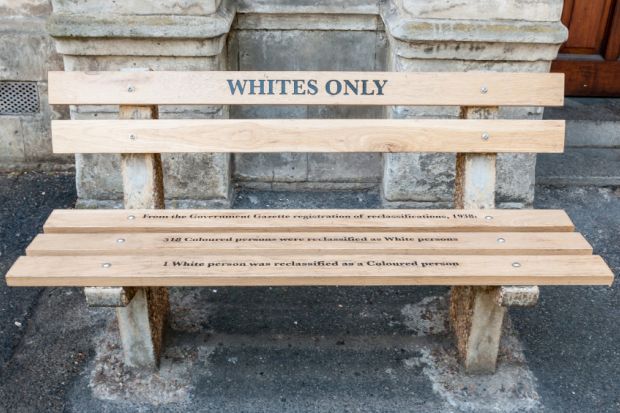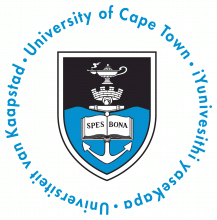Universities often have complicated pasts that shape choices in the present and opportunities for the future. Reconciliation requires acknowledgement of past injustice; reparation requires beneficial action. A little-remarked initiative by Stellenbosch University provides reparation for the consequences of South Africa’s notorious Group Areas Act. Acknowledgement of a shameful event in Georgetown University’s past may result in reparation for the descendants of a group of slaves sold in 1838. Will initiatives like these push universities to do more than say sorry?
The 1950 Group Areas Act was a cornerstone of apartheid legislation, enforcing racial segregation. By the early 1980s, more than 600,000 people had been forcibly removed because they had not been classified as white. Stellenbosch’s Die Vlakte neighbourhood was one of many similar areas in towns and cities across the country, home to some 4,000 people close to the town centre. The university, exclusively white, acquired the land for campus buildings. Although South Africa’s 1994 settlement laid the basis for restitution, this has been a slow and incomplete process. The legacies of apartheid continue to shape access to educational opportunity, prompting frequent campus protests. Stellenbosch University’s Vlakte bursaries, reserved for descendants of the families forcibly removed from this part of the campus, are in recognition of this history and its consequences.
There have also been continuing protests on US campuses, focusing on the legacies of racial discrimination. Georgetown is one of a growing number of American universities that have now acknowledged their historical connections with slavery. In some cases, these have been through founding legacies derived from the slave trade. In others, as with Stellenbosch, the link is embossed on the campus itself. For example, South Carolina’s Fort Hill Plantation was bequeathed to Clemson University and became its campus. Its first buildings were constructed by convict labourers; one student researching the manifest found a relative on the list. Georgetown’s history has a particularly sharp edge; two presidents, both Jesuit priests, sold 272 men, women and children to raise money for the university’s activities.
Universities are increasingly acknowledging these past culpabilities and the complexities of their histories. Approaches to reconciliation often take the form of opportunities for rethinking the curriculum, rather than for offering material reparation. Clemson’s plantation history has been incorporated into a course on 19th-century history. The University of Virginia, founded by plantation-owner Thomas Jefferson, offers a wide-ranging programme on slavery and its legacies.
At the University of Cape Town there is continuing debate about reform of the curriculum. In addition, the university is calling for proposals for renaming buildings like its Jameson Hall, which was inspired by Jefferson’s design for the University of Virginia and named after the colonial adventurer Leander Starr Jameson. Yale has taken a different road, declining to rename a building memorialising a now-notorious slaver. Yale’s president argues that “changing the name ‘Calhoun’ would result in less confrontation with what [John] Calhoun represented and less discussion of who he was and why the building was named for him”.
Moving from reconciliation to reparation is evidently complex. Stellenbosch’s initiative has been criticised as tokenism; the five Vlakte bursaries currently available can benefit very few of the families directly affected by the university’s appropriation of their property. More generally, thousands of others who were also dispossessed by the Group Areas Act have not been given equivalent opportunities for redress. In the US, arguments for reparations for slavery have a long history, and remain unresolved. The Georgetown Memory project has identified a first few direct descendants of those sold in 1838, and is considering what form recompense should take. With time, genealogical research will trace thousands more and, like Stellenbosch, Georgetown will face the difficulty of balancing fairness with practical limitations.
The continuing critical appraisal of curricula in the light of history and current priorities revitalises teaching and research. Forms of commemoration inscribe values on a campus landscape. By edging from reconciliation to reparation, however, both Stellenbosch and Georgetown are signalling that acknowledging the past, and apologising, are insufficient. Stellenbosch was the ideological incubator for apartheid, justifying racial discrimination through Christian theology. Slave trading by Georgetown’s Jesuit presidents, at a time when slavery was being abolished across other parts of the world, prompted concern in Rome and reaction from the Pope. These precedents could be significant as debate continues about our obligations to redress the wrongs of the past.
Martin Hall is the former vice-chancellor of the University of Salford.
Write for us
If you are interested in blogging for us, please email chris.parr@tesglobal.com
Register to continue
Why register?
- Registration is free and only takes a moment
- Once registered, you can read 3 articles a month
- Sign up for our newsletter
Subscribe
Or subscribe for unlimited access to:
- Unlimited access to news, views, insights & reviews
- Digital editions
- Digital access to THE’s university and college rankings analysis
Already registered or a current subscriber? Login








